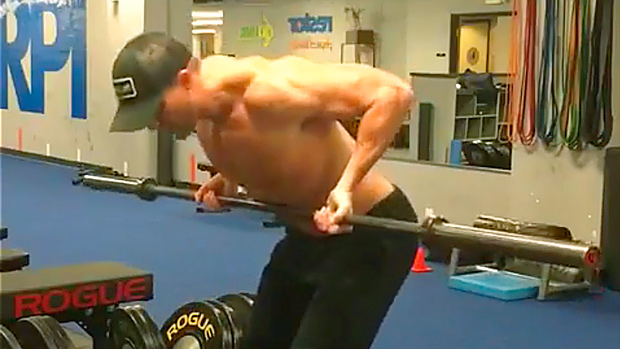The (Really) Strict Pull-Up
We've all been guilty of cheating a pull-up. Some people kip, some do half reps, and others do that "swing" that looks suspiciously similar to a kip. If you want to test your true relative upper-body strength, master a strict pull-up.
This is a little more complicated than it first appears. A strict pull-up involves proper scapular retraction and core engagement so that your torso stays neutral and your ribs stay down during the movement.
A "true" strict pull-up does NOT involve trying to lift your chest to the bar to shorten your range of motion. In fact, the goal of a strict pull-up is to keep the ribs down as you pull yourself upwards. This allows for maximum core engagement.
Here's what the average person's normal pull-up looks like (with a loss of core engagement) verses a very strict pull-up:
Improper Pull-Up
Here the ribs lift and the body goes away from the bar at the top of the movement. The core isn't activated properly. This pull-up is relying on a slight kip to start the movement. And it relies very heavily on the elbow flexors (biceps) to finish the movement. In other words, it looks like shit.
Proper Strict Pull-Up
Notice that the ribs stay down and the body is pulled towards the bar at the top of the movement. This demonstrates proper core engagement.
Where Do You Stand?
If you want to know how you stack up, check out the chart. And remember, we're talking about super strict pull-ups here:

Here's are the steps:
One reason people can't do a strict pull-up is because their core is either weak or not activating correctly. If you struggle to keep the ribs down during a pull-up, try adding the following exercises into your routine to retrain your core to brace properly.
One-Arm Lat Hold
The focus of this exercise is to pull down your ribcage and retract your shoulder blade. Place your opposite arm on your ribcage and feel yourself pull your ribs down. Once you've stabilized your core, remove your hand.
Hollow Body Hold
This gymnast staple is great for teaching you how to tighten up your body. Try to pull your belly button to your spine and flatten your lower back to the floor when doing this exercise. If your back lifts off the floor, modify the movement by bringing your arms down to the sides of the body.
Another reason you may be struggling with the strict pull-up is a lack of scapular retraction and lat activation. Many people rely too heavily on their biceps when trying to perform a pull-up. Practicing the movements below will train you to use the large muscles of the back.
Dumbbell External Rotation
This movement is great for enhancing mobility through the scapula as well training the external rotators of the shoulder to fire correctly.
Hanging Scapular Retraction or "Initial Engagement"
Doing this exercises teaches your lats to engage. Think of pulling your shoulders down from your ears to do this exercise. As you do, make sure you pull your ribcage downward by engaging your core.
If your shoulders ever get pissed off when doing pull-ups, try to do some soft tissue work on the upper pecs and front part of your shoulder. Doing this should loosen them up a bit and will create less restriction during the pull-up.
Body Bar Myofascial Release for the Pec and Shoulder
- In order to get good at a movement you need to train it often. Strict pull-ups should be trained a minimum of two to three times per week.
- This should be one of the first exercises you do during your workouts. Training the movement early on gives you a higher chance of success in mastering it.
- If you don't consider yourself good at pull-ups, you should begin with 5 sets of 5. Trying to do too many reps at first will only engrain bad habits.
- When you first start doing strict pull-ups, only train to technical failure – the most reps you can do with perfect form. Once you feel yourself start to kip, shorten your range of motion, or lose tightness through your core, take a breather.
- If you're currently capable of performing a very strict pull-up, play around with your reps. Try weighted pull-ups for strength or just your bodyweight for endurance.
- Strength sets consist of 3-6 sets of 6 or fewer reps. Make sure you take long rest periods between sets.
- Hypertrophy sets consist of 3-6 sets of 6 or more reps. Keep your rest periods to no longer than one and a half minutes.





